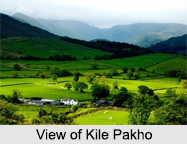 Ziro Valley is a quaint old town, which is located in the lower Subansiri District of Arunachal Pradesh. The entire Ziro is encompassed by Rice fields, lush Bamboo forests and mountains with Pine trees. Considered as a photogenic place by tourists, this place is also popular for its rich wildlife treasures. This town is the home of Apatani tribe, whose festivals, customs and traditions are also as distinctive as the tribe itself. The festivals are animistic ceremonies, murung rituals, colourful dances and unending feasts.
Ziro Valley is a quaint old town, which is located in the lower Subansiri District of Arunachal Pradesh. The entire Ziro is encompassed by Rice fields, lush Bamboo forests and mountains with Pine trees. Considered as a photogenic place by tourists, this place is also popular for its rich wildlife treasures. This town is the home of Apatani tribe, whose festivals, customs and traditions are also as distinctive as the tribe itself. The festivals are animistic ceremonies, murung rituals, colourful dances and unending feasts.
The weather of Ziro is mild which enables the tourists to visit this place throughout the year. This valley is also popular for the Ziro Music Festival, which happens every year in this town in September. The festival started from 2012 and it is a great contribution in positioning this entrancing hill town on an avid traveller"s map. Numerous music lovers, top national & international music bands and folk artists from every corners of the world now travel here during this festival.
Geography of Ziro
Ziro is the district headquarters of Subansiri district and it is also one of the oldest towns in Arunachal Pradesh. It is located at 27.63 ° N and 93.83 ° E at an elevation of 1688 meters to 2438 meters.
Demography of Ziro
Total population of Ziro is 12,806, 50% of which is male population and another 50% is female. 17% of the population is under 6 years of age.
Education in Ziro
There is one university and one undergraduate arts college in Ziro; the names of the institutions are Indira Gandhi Technological and Medical Sciences University and Saint Claret College. According to 2001 census, Ziro had an average literacy rate of 66%, lower than the national average of 74.04%; male literacy was 72%, and female literacy was 60%.
Tourism in Ziro
Apart from its picturesque scenic beauty, there are certain places to visit in Ziro, the details of which are mentioned below:
 Talley Valley Wildlife Sanctuary: Talley Valley Wildlife Sanctuary, also called Bio-diversity Zone, covers an area of 337 sq. km. This place has a wide range of flora and fauna including some endangered species. Orchids, stunning ranges of Bamboo and Ferns are the most common among the plants. This place is considered to be the main attraction of Ziro Valley. On the way to Talley Valley, there is situated the twin hillock Dilopolyang Maniipolyang, which gives beautiful views of its grasslands.
Talley Valley Wildlife Sanctuary: Talley Valley Wildlife Sanctuary, also called Bio-diversity Zone, covers an area of 337 sq. km. This place has a wide range of flora and fauna including some endangered species. Orchids, stunning ranges of Bamboo and Ferns are the most common among the plants. This place is considered to be the main attraction of Ziro Valley. On the way to Talley Valley, there is situated the twin hillock Dilopolyang Maniipolyang, which gives beautiful views of its grasslands.
Meghna Cave Temple: This ancient cave temple dates back to 5000 year, which was discovered in the year 1962. This temple is situated at an altitude of 300 feet. It gives an astounding view of its surrounding area.
Kile Pakho: The Kile Pakho ridge is 7 km from old Ziro which is popular for its amazing scenic beauty. From the Kile Pakho ridge, one can see the Ziro plateau on one side and the snow clad Himalayan ranges on the other side.
Midey: Midey is mainly famous for the Pine trees. Tourists will find the tallest and biggest Pine trees in the whole of Apatani valley. This place is also popular for hiking and trekking among tourists.
Ziro Puto: Ziro Puto is a hillock where the first administrative center was established after independence. Ziro Puto is also known as Army Puto, because Army Cantonment was established in the year 1960. This hillock gives a spectacular view of Apatani plateau.
Dolo Mando: Dolo Mando hillock is located on the west side of Ziro. This place is mainly popular for giving gorgeous views of old Ziro and Hapoli. Tourists often like to choose this place for trekking.
Pine Groove: Pine Groove, one of the most attractive tourists" destinations, is a Pine clad which is situated at a distance of 3 km from Ziro.
 Bamboo Groove: Bamboo Groove is the finest example of farm forestry in this place. One stem Bamboo, which is typically known as monopodial, is cultivated here along with blue clad Pine. This part of Ziro is mostly visited by hikers; tourists often visit this place as well.
Bamboo Groove: Bamboo Groove is the finest example of farm forestry in this place. One stem Bamboo, which is typically known as monopodial, is cultivated here along with blue clad Pine. This part of Ziro is mostly visited by hikers; tourists often visit this place as well.
Apart from the above mentioned places Hapoli, Tarin Fish Farm and Tipi Orchid Research Center are some other places which can also be visited while travelling to Ziro Valley.
Visiting Information to Ziro
Nearest airport from Ziro is at Jorhat, Assam which is 98 km from Ziro. Nearest international airport is in Guwahati (449 km). Nearest railway stations are at Naharalagun (100 km) and North Lakhimpur (117 km). Night buses are also available from Guwahati to Ziro; the buses are operated by Arunachal Pradesh State Road Transport Corporation. One can also reach Ziro via North Lakhimpur or Itanagar by a taxi.



















